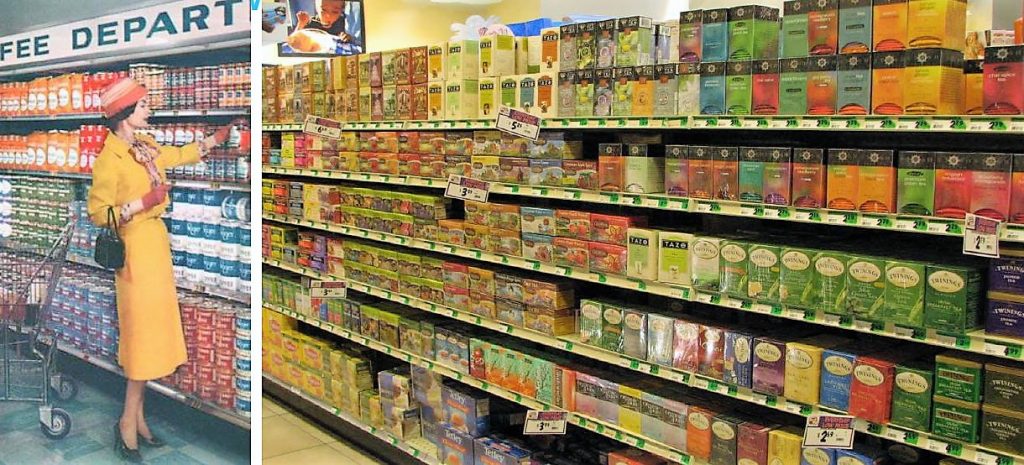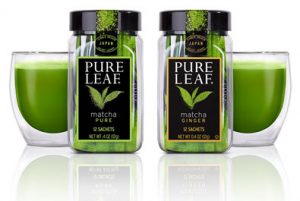

Is the Tea Glass Half Full or Empty?
Convenience is such a powerful driver that loose leaf brands such as Teavana, DAVIDsTEA, and Mighty Leaf are now largely sold bagged. Yet sales of convenient-to-brew Keurig Green Mountain in single-serve capsules declined 23 percent. Sales of Unilever (Lipton) in capsules fell 11 percent, Tazo was down 10 percent for the year, and Hain Celestial dropped 15 percent. All the major brands that package tea in capsules, except Twinings North America, showed steep drops. Even private label teas in single-serve formats showed a 16 percent decline with some versions, like Keurig Diet Snapple in capsules, practically disappearing from store shelves after a 70 percent drop in sales and 74 percent drop in unit volume. “Grocery needs help,” says Jason Dubroy vice president and managing director at TracyLocke, Canada, a 100-year-old consultancy based in Dallas, Texas. “Grocery retailers find it hard to keep pace with how people shop,” Dubroy explained in a presentation at the North American Tea Conference. The center aisles in most grocery stores are identical to what shoppers experienced in the 1960s. While produce and dairy, bakery and deli innovate with lighting, kiosks, patterned wood floors, and murals, the tea and coffee aisle consist of simple shelves crammed with look-alike boxes of tea. This is one reason why Mintel International finds that only 35 percent of all Canadians actually enjoy grocery shopping. Tea’s share of volume in traditional retail is falling, said Dubroy. In Canada, in 2011, 68 percent of tea was sold in grocery. By 2015, that share had fallen to 62 percent, according to Mintel International. Shoppers (63 percent) making purchasing decisions now order products in three or more retail channels, with 8 percent using all six (paper fliers, digital fliers, websites, smart phones, PC/tablet, and store visits). They may not like to trudge through the aisles, but Mintel found 73 percent of shoppers agree that they love the thrill of scoring a deal. “Today’s shoppers are leveraging tools like Checkout 51 or Flipp, flier comparison programs and social couponing. For brands, you need to figure out not just how to give a deal, but to make it fun,” he said. Marketing is rooted in emotion but shopping is governed by action, he says. Dubroy recommends emotional messaging, plus retail innovation to achieve category results. The biggest opportunities in retail lie in developing services to help harmonize brands’ brick-and-mortar, online, and mobile offerings. E-commerce channels are no longer just online marketplaces, but also content hubs, he explains. Brands need to speak to different customers and provide value and utility at shelf. He predicts brands will begin serving up content in store similar to the way they do online.Tea Product Innovation
It is the new stars that are shining on the shelf. KeVita Master Brew Kombucha earned $42 million in 2017 for the 52 weeks ending Dec. 3, according to market research firm IRI Infoscan U.S. multi-outlet. Flavors such as blueberry basil, roots beer, and spicy ginger caught the attention of tea drinkers. Master Brew is naturally sweetened with stevia, organic, non-GMO, low calorie, vegan and dairy, lactose and gluten free. Teas are marketed as probiotic, and fermented with a combination of bacteria and yeast. KeVita offers a coconut-based version, but black tea and green teas are the base for most of its line. Health-Ade Kombucha ($13 million in 2017 sales) is a bubbly probiotic with 2017 sales that grew 189 percent, according to IRI. HUMM ($15 million in sales in 2017) is marketed to active young people with a HUMM-sters team and supports a HUMM Squad. The latter are described as Humm’s "emissaries to the world, each lending their remarkable skills and unique voices to spreading the word about Humm and our kombucha. They include thrill-seeking outdoor enthusiasts and cutting-edge musicians, gifted photographers who portray the beauty of nature, and record-seeking riders who attempt to conquer it.” Sales of HUMM grew 144 percent in grocery last year to 5 million units at an average price of $2.97, according to IRI. Meanwhile, during the same period, sales of Lipton’s bottled iced tea declined 25 percent to $26 million and sales of Nestea fell to $22 million, down 5 percent. The average unit price is discounted to $1.60.Don’t Give Up on Grocery—Yet
Charles Cain, a principal at Building Oz, notes, "Eighty percent of Americans drink tea, and 50 percent do so daily. The specialty tea segment is growing at nearly twice the rate of the overall U.S. tea business, and demographic trends suggest the industry has a long runway of expansion as younger consumers are more inclined to favor tea over coffee than their parents.” Tea is mainly consumed at home, and grocery has long been the primary sales channel for tea. He observes that tea stores in malls “saw dramatic early sales results, but sustained sales growth beyond seasonal gifting required consumers to shift their tea purchasing from the local grocery store to the regional mall. That’s not a behavior we see happening consistently in any other specialty food or beverage industry.” Hartman Group CEO Laurie Demeritt told the Food Navigator that “by the end of the 1950s the impact of the modern self-service supermarket was “still minimal. A couple of decades later, and it had completely transformed the food retail landscape," she said. One thing we do know is that there is an increasing disconnect between the mainline retail ecosystem of thousands of large stores designed for extended 45- to 60-minute pantry stock-up trips, and the way many Americans are now shopping and meal planning (on the cuff), she says. And should pantry shopping ultimately collapse in favor of just-in-time meal shopping, she observes, conventional supermarkets could “more or less vanish within 20 years, replaced by fresh specialists, continued club sales and online sales.”
